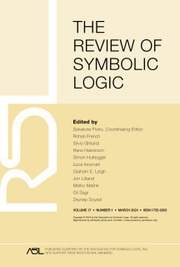No CrossRef data available.
Article contents
FROM REAL ANALYSIS TO THE SORITES PARADOX VIA REVERSE MATHEMATICS
Published online by Cambridge University Press: 12 March 2025
Abstract
This paper presents a reverse mathematical analysis of several forms of the sorites paradox. We first illustrate how traditional discrete formulations are reliant on Hölder’s representation theorem for ordered Archimedean groups. While this is provable in  $\mathsf {RCA}_0$, we also consider two forms of the sorites which rest on non-constructive principles: the continuous sorites of Weber & Colyvan [35] and a variant we refer to as the covering sorites. We show in the setting of second-order arithmetic that the former depends on the existence of suprema and thus on arithmetical comprehension (
$\mathsf {RCA}_0$, we also consider two forms of the sorites which rest on non-constructive principles: the continuous sorites of Weber & Colyvan [35] and a variant we refer to as the covering sorites. We show in the setting of second-order arithmetic that the former depends on the existence of suprema and thus on arithmetical comprehension ( $\mathsf {ACA}_0$) while the latter depends on the Heine–Borel theorem and thus on Weak König’s lemma (
$\mathsf {ACA}_0$) while the latter depends on the Heine–Borel theorem and thus on Weak König’s lemma ( $\mathsf {WKL}_0$). We finally illustrate how recursive counterexamples to these principles provide resolutions to the corresponding paradoxes which can be contrasted with supervaluationist, epistemicist, and constructivist approaches.
$\mathsf {WKL}_0$). We finally illustrate how recursive counterexamples to these principles provide resolutions to the corresponding paradoxes which can be contrasted with supervaluationist, epistemicist, and constructivist approaches.
Information
- Type
- Research Article
- Information
- Copyright
- © The Author(s), 2025. Published by Cambridge University Press on behalf of The Association for Symbolic Logic


